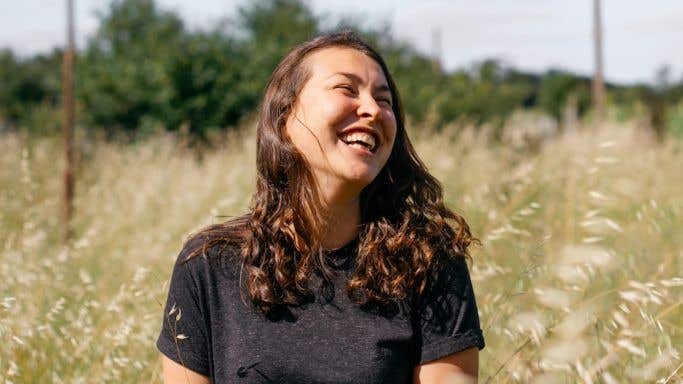A dry Chenin made by a young woman breaking all the rules on the traditional and revered Hill of Chaume, starting at $27.98, £22.95, €26.80, or just €16 for the 2022.
Perhaps it’s just me, but I always get a little thrill when I open a bottle of white wine and the cork is glittering with fine, tiny tartrate crystals – ‘wine diamonds’, someone at the Josmeyer winery told me many, many years ago on a visit to Alsace, when I came across them for the first time. It tells me that the winemaker has chosen not to put the wine through ultra-fine filtration or shocked it with severe refrigeration. It means that no one used charcoal or bentonite or anything else to ‘stabilise’ the wine (ie prevent tartrates from developing). It instantly tells me something about the wine and the philosophy behind the winemaking. As I pulled the cork from Vanessa Cherruau’s dry Anjou Chenin, there they were: like fairy dust, sparkling a little bit of magic on my desk, my hand, the cork.
Unlike most owner-winegrowers of a 25-ha (62-acre) property of contiguous cru-quality vineyards complete with winery in the heart of a classic appellation in France, Vanessa Cherruau did not grow up in a vine-growing or winemaking family or in a family with plenty of money. Quite the contrary – she was born in the south of France and grew up in a military family, moving all over the place as she was growing up. ‘A city girl’, she says. ‘I knew nothing about how plants grew!’ She didn’t inherit vineyards or a wine interest, choosing to study journalism at university, with a plan to be a reporter and travel the globe. Then she went to a wine tasting and realised that it was possible to tell the difference, just by tasting, between left-bank and right-bank wine. It was a penny-drop moment that led to her giving up her reporting job, going back to study (oenology, this time), becoming obsessed with wine (organic and biodynamic viticulture in particular), making wine in the Loire, Penedès and Champagne, and eventually coming back to Anjou, which she’d considered home since the age of 17. ‘I was homesick!’ she says simply.
But she also had a dream: to make her own wine and have her own domaine. She wrote it down: 10, maybe 12 hectares; good-quality vineyards; a winery; maybe even organic vineyards. So she began putting the word out, chatting to people, looking. One day, a man said to her, ‘Come, I have something to show you.’ He took her to Château de Plaisance. ‘Oh my’, she said. ‘It was everything and double.’ Château de Plaisance, with its enviable chunk of Chaume and Quarts de Chaume vineyards, had been owned and run for many years by the outspoken, ‘swearing every second’, one-time rebel Guy Rochais. (He was the first person to make a dry white Chenin from his Chaumes vineyards and was prosecuted by the authorities for labelling it Chaumes AOC – undeterred, he carried on making it and labelled it L’Insolent instead.) Rochais farmed organically, achieving certification in 1995, and the estate has been certified biodynamic since 2008, but one thing and another had led to a slow decline in maintenance and production. Plaisance needed love, attention and a lot of capital – not to mention the money to buy it in the first place. This is amazing, she thought. Except for that thorny question of money …
No worries, said the man, I have two friends. Not even a day later, the 31-year-old Cherruau was on a train to Paris, heading for a (cool) wine bar to meet the ‘two friends’. They were keen to invest. They drank plenty of Chenin, of course, and everyone was excited and thrilled and shook hands and plans were hatched and Cherruau came back with a head full of huge dreams that were about to come true.
But life happens and the investors pulled out and she was left with a sale agreed, no money to go through with it, her dreams in tatters. And, it must be said, newly pregnant. (She found this out only after all the Chenin in that Paris wine bar.) But Cherruau is a determined young woman, and not long after, in March 2019, she found another investor. Guy Rochais handed the keys of the estate to her on 12 September 2019. They started harvest on 13 September 2019. Her baby was born on 14 October 2019. Harvest had just finished.
Together with her permanent team of five (including two people who were working at Plaisance when she took it over, and school friend Guillaume Kieffer) Cherruau continues to farm organically and biodynamically. But, she says, there is much further to go. The first thing she changed was the vineyard soil management – they no longer plough but allow native grasses and herbs to grow between the rows and then roll and mulch them down into the soil. Copper-sulphate spraying when mildew pressure is high is done by precision with only the tiniest amount when and where necessary. She is uncompromisingly committed to restoring the biodiversity of the property. She has obtained LPO (the French league for the protection of birds) certification, has installed bat houses, is replanting hedges, and has started a programme of agroforestry – planting fruit and nut trees in the vineyards. They no longer burn their pruning offcuts as is traditional in the region – they’ve found a supplier who turns them into matchsticks. Further than that, bottle weights have been reduced so a pallet going for export now weighs half of what it used to, and boxes and labels come from recycled paper. They use vegetable inks, strictly sort all their waste and are looking to join a scheme that provides them with washed, sterilised, reused bottles. She is, she says, considered a bit crazy by many of the more traditional Layon producers (who consider the ‘neatness’ of heavily ploughed and herbicide-blitzed vineyard rows to be a sign of good wine). She is, however, heading up a quiet revival and revolution.
Despite having vineyards wrapped around the winery on the hill of Chaume, famous for its sweet wines, she makes wines that are resolutely dry. She makes two red wines from 5 ha of Cabernet Franc and Cabernet Sauvignon, a Savennières and three Anjou whites including Ronceray and a single-parcel cuvée called La Grande Pièce. But it was thanks to her L’Anjou Blanc that I discovered this remarkable young winegrower. She says it is important to her to make a wine that is accessible in style and in price, explaining that because of the very low yields in Chaumes, wines are inevitably more expensive. L’Anjou Blanc comes from four parcels of young vines on schist – under 20 years old, because these vines give the fruitiest expression of Chenin. It is hand-picked and undergoes a very slow cold pressing. She adds a tiny amount (2 g) of sulphites at press. Fermentation is spontaneous and when it comes to malo, ‘the wine decides’. Usually some tanks go through malo and some don’t. The wine then spends 11 months in stainless steel before bottling.
Considering this is her ‘entry-level’ Chenin, the complexity is marvellous (I can only imagine what her other whites are like). It doesn’t taste remotely simple and fruity. It is, rather, a matrix of remarkably pure fruit and crystalline acidity. You can feel the tension, which, to begin with, seems almost austere, like the high-wired, humming tension of winter power lines, ready to snap against a cold, white sky. But the ripeness of the fruit spills over, flooding every corner with golden apple, quince, yellow pear and the zesty brightness of satsuma. On the finish, a hint of stoniness. It’s just 13% alcohol and the best pairing for this wine must surely be outside, sitting in the grass in the sunshine. It is likely to be as fresh and pleasurable to drink in eight years’ time as it is now, and will probably last a decade.
In the UK, it’s available from Vin Cognito, Lea & Sandeman and Noble Green Wines (the 2020 and 2022 vintages are also available from a number of independent wine merchants). In the US, it’s imported by Becky Wasserman and Skurnik, and you can find it in New York State, Connecticut and California. The 2022 also available, at just €16, via the producer’s website.
Members can find reviews of more than 100 Anjou Chenins in our tasting notes database.






